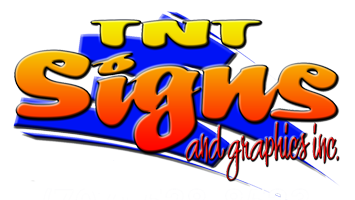Color is more than just a design choice—it’s a powerful tool that can shape customer perception, evoke emotions, and influence purchasing decisions. When it comes to business signage, color selection is critical in ensuring that your message is not only seen but also felt and remembered.
At TNT Signs, we specialize in crafting custom signs that go beyond aesthetics, incorporating the science of color psychology to help businesses establish a strong, memorable brand presence. In this blog, we’ll explore how different colors impact customer perception, how to choose the right color for your signage, and real-world examples of effective color usage in business branding.
Why Color Choice Matters in Business Signage
Before a potential customer even processes the words on a sign, their brain reacts to its colors. Research shows that color increases brand recognition by up to 80%, influencing everything from customer trust and emotional response to purchase intent.
Imagine a luxury hotel with signage in bright neon green—it would likely feel out of place and fail to convey the elegance the brand wants to project. On the other hand, a children’s play center with muted gray tones may feel uninspiring rather than fun and welcoming.
This is why choosing the right colors for business signage is essential for branding success. The right colors help:
- Attract attention and make your signage stand out.
- Evoke emotions that align with your brand’s personality.
- Establish credibility and trust with potential customers.
- Reinforce brand recognition for long-term impact.
Let’s explore how specific colors can influence perception and when they work best in business signage.
Understanding Color Meanings in Business Signage
Each color carries psychological associations that impact how customers interpret signage. Here’s a breakdown of the most common colors and their business applications:
1. Red: Energy, Urgency, and Excitement
Red is bold, dynamic, and hard to ignore. It is commonly used in industries where businesses want to stimulate urgency or excitement, such as:
- Fast food chains (e.g., McDonald’s, KFC) to stimulate appetite.
- Retail stores for clearance sales and discounts.
- Sports brands to convey energy and action.
Best used for: Urgent promotions, call-to-action messaging, and brands that thrive on passion and excitement.
2. Blue: Trust, Reliability, and Professionalism
Blue is one of the most widely used colors in business signage because it creates a sense of security and stability. It is favored by industries such as:
- Financial institutions (e.g., Chase, PayPal) to establish credibility.
- Healthcare providers to evoke calmness and trust.
- Tech companies (e.g., Facebook, Dell) to convey innovation and dependability.
Best used for: Professional service firms, corporate branding, and businesses that want to appear trustworthy.
3. Green: Health, Growth, and Sustainability
Green is associated with nature, renewal, and well-being, making it a go-to color for environmentally conscious brands and wellness businesses.
- Organic and health-focused companies use green to communicate sustainability.
- Financial institutions leverage green to symbolize prosperity and growth.
- Outdoor and eco-friendly brands use green to reinforce their connection to nature.
Best used for: Health, wellness, finance, and environmentally focused brands.
4. Yellow: Optimism, Friendliness, and Attention-Grabbing
Yellow exudes warmth and positivity, making it a great choice for businesses that want to create an inviting atmosphere.
- Children’s brands and family-friendly businesses use yellow to convey playfulness.
- Retail stores use yellow in signage to capture attention from a distance.
- Food brands pair yellow with red to create hunger-inducing color schemes.
Best used for: Businesses that want to appear welcoming, energetic, and youthful.
5. Black: Sophistication and Luxury
Black conveys elegance, authority, and exclusivity. Many high-end brands use black to project luxury and prestige.
- Luxury fashion brands (e.g., Chanel, Prada) use black for a sleek, premium feel.
- Law firms and corporate brands use black to signal authority and professionalism.
- Minimalist brands favor black-and-white schemes for a modern aesthetic.
Best used for: Upscale businesses, high-end retailers, and professional service industries.
6. White: Cleanliness and Simplicity
White represents simplicity, purity, and clarity, making it ideal for:
- Medical and wellness brands that want to project cleanliness and tranquility.
- Modern retail spaces that emphasize minimalist branding.
- Tech companies using white for a sleek, futuristic look.
Best used for: Healthcare, wellness, and businesses that embrace minimalism.
How to Choose the Right Color for Your Business Signage
At TNT Signs, we guide businesses in selecting colors that align with their brand identity and marketing goals. Here’s how we help:
1. Define Your Brand Personality
Is your brand energetic and playful, or sophisticated and professional? The colors you choose should align with your brand’s character.
2. Consider Your Target Audience
Different demographics respond to colors differently. For example, younger consumers may prefer bold, vibrant hues, while an older audience may resonate more with classic, muted tones.
3. Evaluate the Sign’s Environment
Where will the sign be placed? Bright colors work well in high-traffic areas, while subtle colors may suit indoor spaces better.
4. Test Visibility and Readability
Contrast is key—your text should stand out against the background for maximum legibility. Dark text on a light background (or vice versa) ensures readability from a distance.
Real-World Examples of Effective Color Usage in Signage
Many major brands use color psychology to reinforce their messaging. Some examples include:
- Coca-Cola (Red & White): Uses red to stimulate excitement and white for balance and contrast.
- Starbucks (Green & White): Leverages green to emphasize its commitment to sustainability and relaxation.
- UPS (Brown & Yellow): Uses brown to communicate reliability and yellow for warmth and friendliness.
By taking cues from these industry leaders, small businesses can create signage that attracts attention and strengthens their brand identity.
Final Thoughts: The Power of Color in Business Signage
Choosing the right colors for your business signage isn’t just about making it look attractive—it’s about strategically influencing customer perception and engagement. By leveraging color psychology, businesses can create signs that drive recognition, build trust, and boost sales.
At TNT Signs, we specialize in designing high-impact business signage that effectively uses color to reinforce brand identity. Whether you need a bold, attention-grabbing storefront sign or a sleek, professional office sign, we’re here to help.
Ready to create a sign that leaves a lasting impression? Contact TNT Signs today for a consultation!




